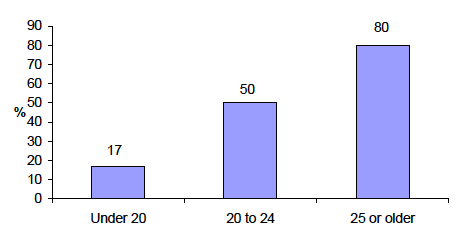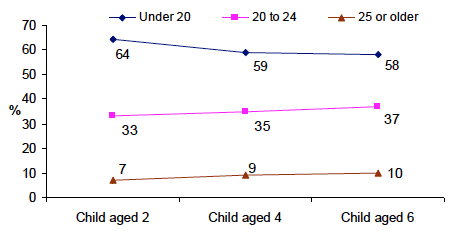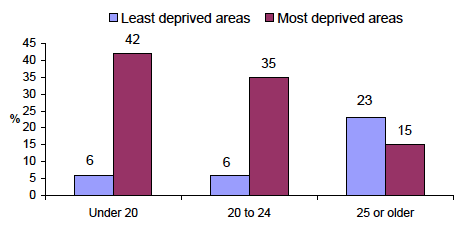The Experiences of Mothers Aged Under 20: Analysis of Data From the Growing up in Scotland Study
Analysis of Growing Up in Scotland data on the circumstances of first-time mothers in Scotland who were aged under 20 at the time of the child’s birth. Data collected up to the child’s sixth birthday were used to compare these circumstances with those of mothers who were aged 20 to 24 and aged 25 or older at the time of their child’s birth.
2 Socio-Economic Characteristics
Introduction
2.1 The first section compares the socio-economic characteristics of mothers aged under 20 - in terms of their educational qualifications, employment and economic activity and household income - with those of older mothers aged 20-24 and 25 or older. Differences in housing tenure and area deprivation are also explored. This chapter therefore presents the important and influential context within which young mothers start their parental journey and within which the findings in subsequent chapters should be considered.
Key findings
- When the child was aged 10 months, 17% of mothers aged under 20 had a qualification at Higher Grade or above compared with 50% of mothers in their early twenties and 80% of those aged 25 or older.
- As may be expected, more mothers aged under 20 have qualifications at Higher Grade level or above when their child was aged six than they did when their child was aged two. Although acquisition of qualifications increases as their child grows, even when their child is aged 6, mothers aged under 20 at the time of their child's birth remain the group least likely (by a significant margin) to have these qualifications.
- At 10 months, 21% of mothers under 20 were employed (either full-time or part-time) compared with 55% of those in their early twenties and 83% of those aged 25 or older.
- As the child ages, mothers aged 25 or older remain most likely to be in employment and mothers aged under 20 remain least likely. Employment levels amongst mothers aged under 20 do increase over time however, whilst for other groups they remain similar so that by age six the gap is narrower than at age two.
- 72% of mothers aged under 20 had a household income amongst the lowest 20% of all family incomes at 10 months (the bottom 'quintile'). By comparison, the same was true for 40% of mothers aged 20 to 24 and just 12% of those aged 25 or older.
- At all age points, mothers aged under 20 are significantly more likely than other mothers to be in the lowest income quintile.
- Mothers under 20 are considerably more reliant on state benefits and tax credits than are older mothers. This position remains as the child ages.
- The majority of mothers aged under 20 lived in social rented housing and were the group most likely to do so. The figure increased over time with a corresponding decrease in the proportion living in owner-occupied housing.
- Mothers aged under 20 are more likely than older mothers to live in the most deprived areas. The gap between them and those aged 25 or older does not change over time.
- In all measures of socio-economic characteristics, mothers aged 20-24 fall between those younger and older. As such they are in a relatively advantaged position when compared with the youngest group - having more qualifications, more likely to be in employment and having higher average incomes - yet nevertheless at a significant disadvantage when compared with older mothers.
Educational qualifications
2.2 With many mothers under 20 falling pregnant before completing school certification course such as Standard Grades and Higher Grades, it is unsurprising that their qualification levels are significantly lower than those of mothers in their early twenties and those aged 25 or older (Figure 2-A). When the child was aged 10 months, 17% of mothers aged under 20 had a qualification at Higher Grade or above compared with 50% of mothers in their early twenties and 80% of those aged 25 or older.
Figure 2-A % of mothers with a qualification at Higher Grade or above when child was aged 10 months, by maternal age at child's birth

2.3 The trend data (Table 2.2[14]) shows that mothers aged under 20 do resume their education following the child's birth, but nevertheless continue to have significantly lower qualifications than all older mothers. When the child was aged two, around a quarter (24%) of mothers aged under 20 had achieved a qualification at Higher Grade or above compared with three-quarters (76%) of older mothers. By age six this gap had reduced, however, with the proportion of mothers aged under 20 holding these qualifications increasing to 37% whilst the figure for older mothers changing only slightly to 77%.
Employment
2.4 When their child was aged 10 months old, mothers aged under 20 were significantly less likely to be in employment (including on maternity leave) than those aged 20 or over (Table 2.3). As maternal age increased, so too did likelihood of employment. At 10 months, 21% of mothers under 20 were employed compared with 55% of those in their early twenties and 83% of those aged 25 or older.
2.5 The patterns of economic activity for mothers in the different age groups continue to vary at ages two, four and six (Table 2.4). 28% of mothers aged under 20 were in employment when the child was aged two, a significantly lower proportion than the 79% of mothers aged 25 or older who were employed. Employment rates amongst mothers aged under 20 did increase over time however, reaching 43% by age six, though this was still considerably lower than for older mothers whose rate remained similar.
2.6 Those mothers who were not employed were mostly not in education or training, nor were they looking for work. Most mothers in all age groups said they were looking after the home or family[15]. Mothers aged under 20 were more likely to say they were doing this at all sweeps of the data, which is unsurprising given their lower propensity to be employed.
Income and benefits
Equivalised income[16]
2.7 Most mothers aged under 20 (72%) had a household income amongst the lowest 20% of all family incomes at 10 months (Table 2.5). By comparison, the same was true for 40% of mothers aged 20 to 24 and just 12% of those aged 25 or older.
2.8 The proportion of mothers in the youngest group with this low level of income reduced slightly over time - from 64% at age two to 58% at age six (Table 2.6, Figure 2-B). Nevertheless, they remain the age group most likely to have incomes at this level. At least one-third of mothers in their early twenties were also in the lowest income group at each age point. They were more likely to have relatively lower incomes at age six than age two (the proportion in the lowest income group increasing from 33% to 37%). With the proportion of older mothers in the lowest income group also increasing very slightly over time (from 7% to 10% at age six) the gap between the youngest and oldest groups decreased slightly but nevertheless remained hugely disproportionate.
Figure 2-B % of mothers with an annual equivalised household income in the bottom quintile by child's age and maternal age at child's birth

the bottom quintile by child's age and maternal age at child's birth" />
Receipt of benefits and tax credits
2.9 With significantly lower employment rates, it is perhaps unsurprising that mothers aged under 20 are considerably more reliant than older mothers on welfare benefits and tax credits for income (Table 2.7). For example, around nine out of ten (89%) mothers under 20 were in receipt of child tax credit when the child was ten months old compared with around four in ten mothers aged 25 or older (41%). Those in their early twenties, whilst less likely (77%) than mothers in the youngest group to receive child tax credit, were nonetheless significantly more likely than the oldest mothers to do so.
2.10 Although less likely to be employed than those aged 25 or older, amongst those who were, mothers aged under 20 were more likely to be receiving working tax credit (19% compared with 15%). However, mothers in their early twenties were significantly more likely than those younger and older to be receiving working tax credit (33% did so when the child was aged 10 months old). This suggests that the jobs held particularly by mothers aged 20 to 24 and those aged under 20 are more often low-paid and/or with fewer hours. Indeed, 86% of mothers aged under 20 who worked and 78% of mothers aged 20-24 who worked did so for less than 35 hours per week compared with 53% of mothers aged 25 or older.
2.11 The trend data suggests that mothers aged under 20 and aged 20 to 24 continue to be more likely than those aged 25 or older to claim tax credits as the child ages[17] (Table 2.8). However, whilst the proportion of mothers aged under 20 receiving working tax credit increased between ages two and six (from 30% to 41%) for older mothers it decreased (from 44% to 35% for those aged 20 to 24 and from 21% to 17% for those aged 25 or older).
2.12 The proportion claiming child tax credits remains stable over time for those under the age of 25 and is considerably higher than for mothers aged 25 or older at both time points. Indeed, the proportion of older mothers receiving this tax credit decreases from 69% to 60% at age six.
2.13 Patterns were similar for other benefits, although larger differences emerge between mothers under 20 and those in their early twenties. When the child was aged 10 months, 57% of mothers under 20 received income support, 51% received housing benefit and 43% received council tax benefit. The comparable figures for those aged 20-24 were lower (at around 24% for each benefit) but the proportion of those aged 25 and older receiving these benefits was much lower again at around 5-6% for each benefit.
2.14 The disparity remains over time as do the differences by age group. For example, the proportion of mothers claiming housing benefit increases from 42% at age two to 46% at age six for those aged under 20, increases from 21% to 25% for those in their early twenties but remains at around 4% amongst mothers aged 25 or older.
Housing and area
Housing tenure
2.15 When the child was aged 10 months, 11% of mothers aged under 20 lived in an owner occupied home with the remainder mostly in rented accommodation including 59% in social rented homes and 25% in private rented homes (Table 2.9). Amongst all of the age groups, mothers under 20 were least likely to live in owner occupied accommodation and most likely to live in social rented accommodation. For example, 40% of mothers in their early twenties lived in a social rented home and just 9% of mothers aged 25 or over did so.
2.16 From age two to age six, the vast majority (around 83%) of mothers aged 25 or older were living in owner occupied homes (Table 2.10), and around 10% lived in socially rented housing. Patterns for both groups of mothers under the age of 25 were significantly different from those of mothers aged 25 or older, being more likely to change over time. At age two, most mothers aged under 20 lived in socially rented housing with the proportion increasing from 65% to 72% at age six. Mothers in their early twenties were less likely to live in socially rented housing than those aged under 20, but the proportion that did similarly increased, from 43% at age two to 48% at age six. There is a corresponding decrease for mothers in both age groups in the proportion living in owner occupied and 'other' accommodation.[18] With figures for older mothers remaining largely static, the difference in tenure characteristics between them and younger mothers therefore increased over time.
Area deprivation
2.17 Area deprivation[19] scores were separated into five equal groups or 'quintiles'. The distribution by age group when the child was aged 10 months is shown in Table 2.11. Most mothers under 20 (72%) lived in an area in either the most or second most deprived quintiles. They were more likely to do so than both mothers in their early twenties (61%) and those aged 25 and older (33%). Notably, mothers in the two youngest age groups are quite similar on this measure and considerably different to those aged 25 and older and those under 25 (Figure 2-C).
Figure 2-C % of mothers living in areas in the least and most deprived quintiles when child was aged 10 months, by maternal age at child's birth

2.18 This relationship between maternal age and area deprivation continued through ages two, four and six (Table 2.12). For example, at age two, 50% of mothers aged under 20 lived in an area in the most deprived quintile compared with 41% of mothers aged 20-24 and 15% of those aged 25 or older. This distribution remained broadly the same at ages four and six. However, both mothers aged under 20 and mothers aged 25 or older were slightly less likely to be living in an area in the most deprived quintile at age six. This reduced from 50% to 46% for mothers aged under 20 and from 15% to 12% for those in the oldest group.
Contact
Email: Liz Levy
There is a problem
Thanks for your feedback